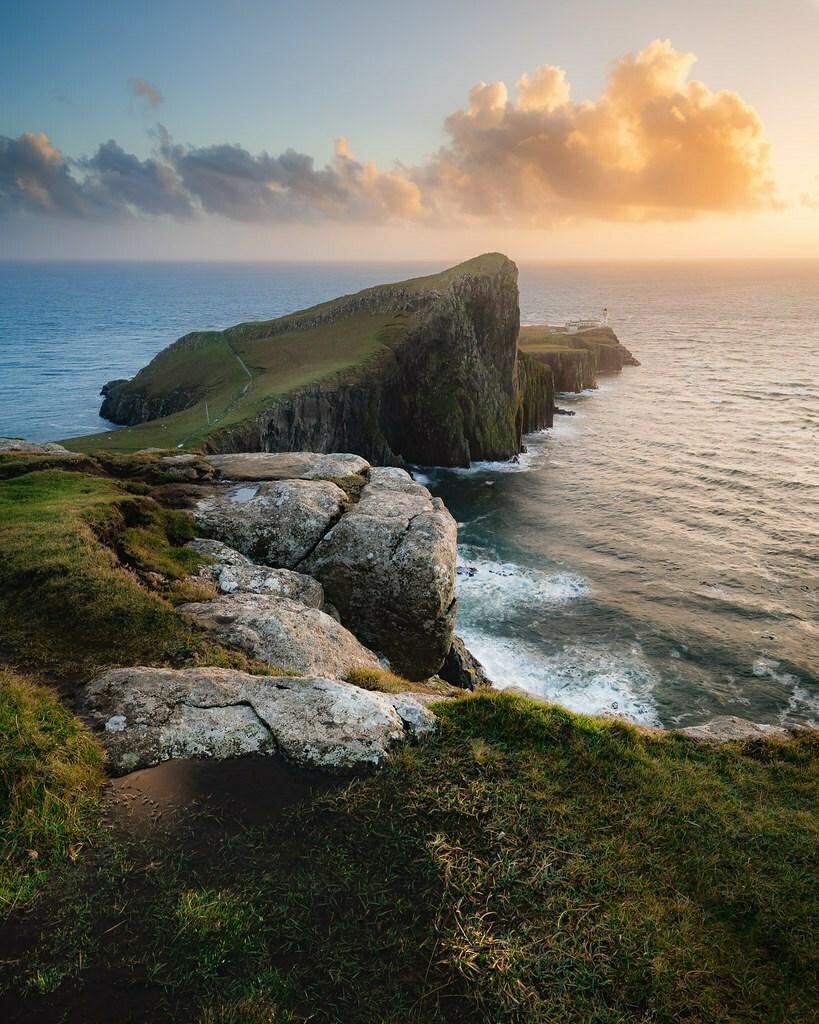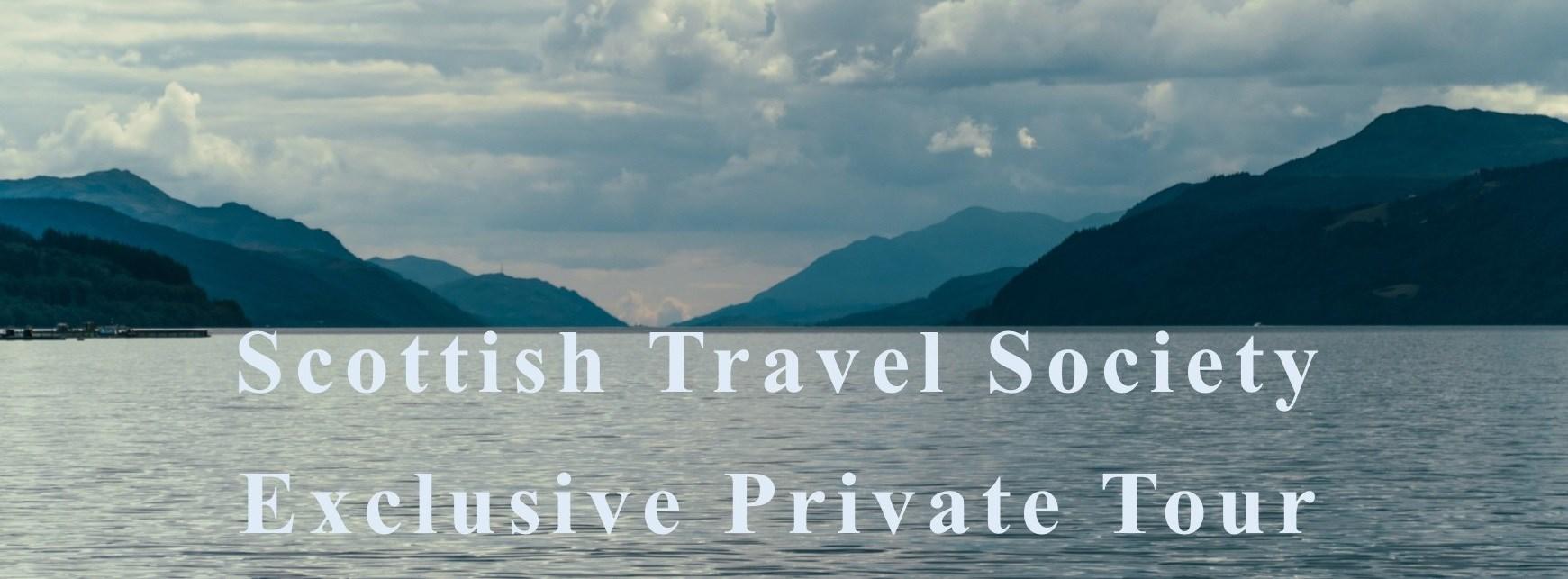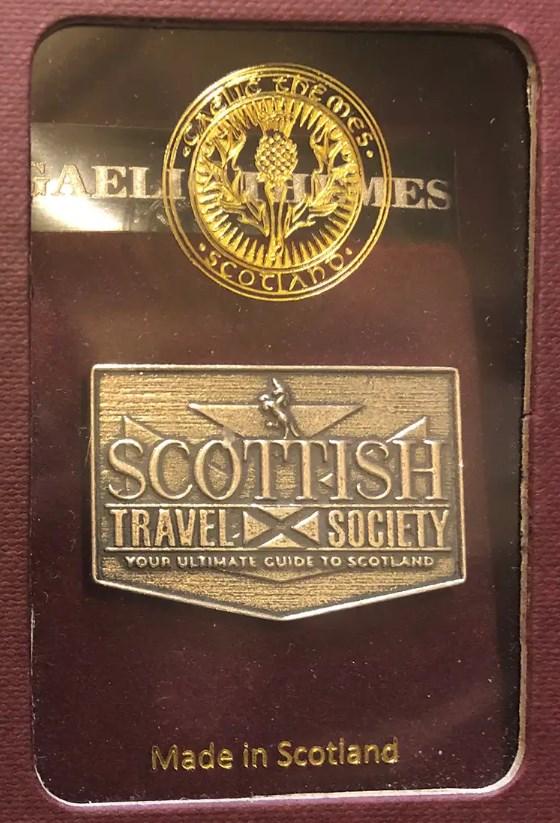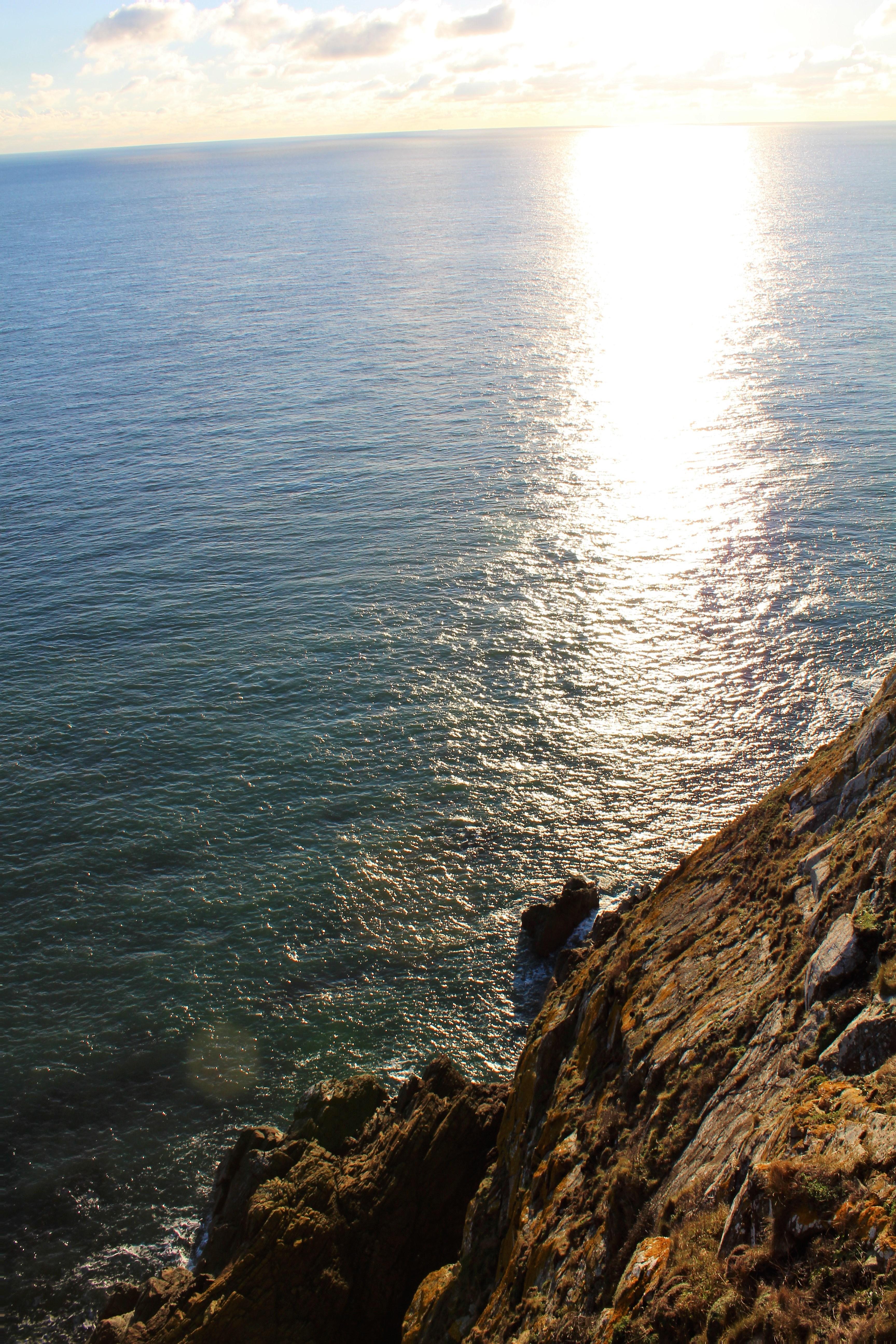







Issue 2 Edition 1 Summer 2023 Focus on Carradale, Kintyre BOB DYLAN, SCOTLAND, AND RABBIE BURNS YOUR ‘SELFIES’ Hidden gems No.2

Travel Scotland

is produced and published by CQ International Publishing for, and on behalf of, Scottish Travel Society LLC.
Design and layout by PeeJay Design Studios, UK.
Cover photo Neist Point, Isle of Skye
Courtesy of Aljaž Vidmar. (Pixels.com)


Travel Scotland magazine is produced and published by CQ International Publishing for, and on behalf of, The Scottish Travel Society LLC.

The opinions expressed in Travel Scotland magazine are those of the authors, journalists, and contributors and do not necessarily reflect the opinions of CQ International publishing, or The Scottish Travel Society, or its Editors.
Information contained in the Travel Scotland magazine is from sources believed to be reliable, many of which are transcribed directly from varied sources and should be considered for information, and or entertainment purposes, only. Neither CQ International Publishing, nor The Scottish Travel Society guarantees the accuracy or completeness of any information published within Travel Scotland magazine and neither CQ International publishing, or The Scottish Travel Society, nor its contributors, journalists, or editors, shall be responsible for any errors, omissions, or claims for damages, including exemplary damages, arising out of use, inability to use, or with regard to the accuracy or sufficiency of the information contained in Travel Scotland magazine or any associated publications.
Paid advertisements appear in Travel Scotland magazine. CQ International Publishing and The Scottish Travel Society do not evaluate advertised products, services, or companies, nor any or all claims made in any advertisement, promotion, or marketing, or by any advertiser. Advertisers making claims are expected to have research data that substantiates these claims. Advertising does not influence editorial decisions or content. CQ International Publishing reserves the right to refuse, reject, or cancel any advertisement, promotion, or marketing content for any reason, at any time, without liability.
Solicited, and unsolicited articles, contributions, photographs, images, and artworks regarding, or associated with Scotland, are welcome.
Email, STSmarketing@mail.com
Advertising, advertorials, marketing, and promotional enquiries to email below.

Advertising agents, and media buyers enquiries open. Standard commission rates apply.
Email CQinternational@mail.com
© CQ International Publishing 2023 ALL RIGHTS RESERVED
No part of this publication may be reproduced, distributed, or transmitted in any form or by any means, including photocopying, recording, or other electronic or mechanical methods, or for digital controlled lending, without the prior written permission of the publisher, except in the case of brief quotations embodied in critical reviews and certain other non-commercial uses permitted by copyright law.
CQinternational@mail.com

LINKS
Embedded hyperlinks in this magazine allow you to simply ‘click’ on them to be taken to the Website, Product, or Service you require.


A link may look like this: https://scottishtravelsociety.com Or this , Click HERE Both work the same way.


In addition, most advertisements are embedded with links. Just click on the advert to be takenen to their website.
For example, on page , Lynne Bodry Shuman has an advert for her book Glasgow to Heathrow
This is it...


travelscotlandmagazine@mail.com
Page 17 Bob Dylan’s Scottish connection
Page 22 Selfies (part one)
Page 25 Focus on Carradale (part one)
Page 30 Kelpies art offer
Page 35 Cullen Skink, Recipe
Page 38 Selfies (part two)
Page 41 Peter Pan








Page 44 A Snippet about Scotland
Page 47 Hidden Gems No.2
Page 51 Focus on Carradale (part two)
Page 56 A Snippet about Scotland
Page 58 DEB WILKINSON (artist)
Page 60 Atlantic Puffins
Page 62 Medical care & emergencies
Chasing
Page 11
the Merrie Dancers
Did you miss the Spring 2023 edition?

Don t worry, you can read it now Click on the cover image above and enjoy



Summer is finally with us, and so is the Summer edition of Travel Scotland magazine, ready to bring some sunshine your way.
What a fantastic edition this is too, full of insights and entertaining facts you will love reading about. Travel Scotland has highlighted a couple of books we are certain you will find helpful, especially if you are planning a road trip or campervanning… is that a word? It is now!
You will find some ‘Snippets of Scotland’ scattered about the pages. These are short outline articles to whet your appetite about things you may not know about Scotland.
Who does not love the iconic Kelpies? In this edition of Travel Scotland, we bring you a way to keep these wonderful, mythical creatures at home, forever.
Enjoy the articles about the Aurora Borealis, Bob Dylan and Robbie Burns, Peter Pan, Atlantic Puffins, Hidden Gems and more, along with tips on what to do when medical help is needed.
Are you looking for a guided tour, then check out Scottish Travel Society’s Speyside Whisky Tour, and our Loch Ness Circular and Inverness Day tour. Both are exclusive to STS, and especially created for our clan members.
Finally, you will find ‘Your Selfies’ inside. The response to our request for photographs was amazing. We got so many we are running the selfie pages in the next couple of issues of Travel Scotland just so we can show them all.
Thank you to all who sent their images to us.
May I wish you a great summer whether you are visiting us this year or planning a future vacation. Please scroll down, like and ‘subscribe’ to Travel Scotland magazine… it’s free! And you will be automatically notified each time an issue is published.
Enjoy and keep happy.
Paul











SPEYSIDE WHISKY TOUR

This Exclusive STS Private Tour visits Speyside and takes you to The Glenfiddich Distillery and The Speyside Cooperage. It is an excellent whisky tour and represents fantastic value, as included in the price is the Distillery Tour with 4 fantastic drams, a 12 year old, 15 year old, 18 year old, and the 21year old Gran Reserva.
8.45am, leave Inverness and proceed South towards Grantown on Spey, where we stop briefly at the old bridge over the river Spey for a photo opportunity, you may even be lucky and see some salmon leaping out of the water.
We continue along the road by the River as it winds its way Northwards towards the sea. We pass by Ballindalloch and on through Aberlour as we make our way to Dufftown, and Glenfiddich Distillery.
11:00am, Tour of Glenfiddich Distillery. Enjoy a guided tour of the Distillery followed by a tasting of 4 Delicious Drams. Glenfiddich is one of the few Single Malt Distilleries to remain entirely family owned.
The Tour takes arbout one and a half hours; the cost of £20 per person is exceptional value as your four Drams are included.



1:15pm, following your tour of Glenfiddich, we go to The Mash Tun pub in Aberlour for Lunch. The Mash Tun stocks an extensive range of Single Malt Whiskys and the Food is delicious, please look at their website, www.mashtun-aberlour.com

3:00pm, after lunch we proceed to Craigellachie, and visit the Speyside Cooperage, taking a tour to discover the ancient art of Coopering, and a journey through the life of the whisky cask. This tour takes approximately 45 minutes, and costs £5 per person. Arriving in Inverness, arriving at 5:30pm.
For full details click

Chasing the Merrie Dancers


Nearly as elusive as the Red Squirrel, the Aurora Borealis AKA the Northern Lights, or the Mirrie Dancers can, unlike the Red Squirrel, can often be seen. (Okay, that’s a personal joke)
The Northern Lights are space weather, which is generated from a Coronal Mass Ejection (CME) from the sun. Solar storms on the sun eject enormous clouds of electrically charged particles (CMEs) that are
be sent through space, directed towards at Earth. Some of these particles get trapped by the Earth's magnetic poles, colliding with atoms in the Earth's atmosphere, causing the Aurora. The closer you are to the North or South Poles, the more likely you are to see the Northern, or Southern (Aurora Australis) Lights… providing on the weather conditions.

The Northern Lights can also be caused by

Asubmittedarticle
something entirely different called a CoInteracting Rotation, or CIR. CIRs happen when the Earth transitions through slow and fast-moving streams of solar wind. Plasma piles up in these areas, which can create a shock wave in the Earth's magnetic field at the poles, which like a CME can cause the Aurora.

A frequently asked question on the Scottish
Powerball.
The Northern Lights can, on occasion be seen as far South as North Carolina, USA, which is at an extremely low Latitude. Shetland, Scotland is only some 300 miles from the Arctic Circle and is perfectly situated for Aurora hunting, due to its high latitude and some seventeen hours of darkness in the winter months.
Travel Society Facebook wall is: Can I see the Northern Lights in Scotland?
The answer is absolutely you can… dependent on several variables. Everything must be exactly right. It's like winning the lotto with all the right numbers and the
Shetland during the clear dark nights of Winter. On a good night with the right conditions, the Northern Lights can be seen throughout Scotland; this was the case at the beginning of March 2023, when one of the best displays seen in a long time burst

out from Shetland to the Scottish Borders and beyond. Here is your recipe for being for viewing the aurora.
Firstly, you need to know what to look for. A good way to test yourself is if you are flying overnight to Scotland from North America, get a window seat on the LEFT side of the aircraft. I've seen the Aurora from the plane three times while flying to Scotland.
The Aurora DOES NOT usually appear to the naked eye as it does in all of the amazing and glorious photographs (MOST of the time.) Our eyes simply do not see as much light as a camera.
On a super good night, you absolutely can see a brilliant vibrant colorful display of reds, greens, pinks, and even purple. The reality is more often the Aurora looks like a milky whitish haze in the sky.
It is there, but unless you know what you are looking for you might just think you are seeing a hazy sky. This is where your camera is needed.
Back to the airplane…undoubtedly, you are flying above the clouds. If you see the haze in the sky, set your camera to have its aperture open (I'm talking iPhone and the like, not professional gear, which I don't own) as long as possible and take some pics
out of the window… you might be completely amazed to see that white haze you see with your naked eye is green, or red in the photograph.
Our eyes are not able to see things the way a camera can. The same goes for being on the ground anywhere in Scotland. If you are on the ground in Scotland snap a pic of the Northern sky and you will intuitively know if you are seeing haze or aurora. Back to the recipe
To increase your chances of viewing the aurora you should be as far North as possible. Shetland is an ideal place in the UK for viewing the Mirrie Dancers. (This doesn't mean you can't see the Northern Lights as far South as Edinburgh, or the Borders.)
You will need a clear, moonless night, away from light pollution, (light pollution is the enemy, along with clouds and rain) and have a CME hurling through space and colliding with Earth on the night you are trying to view this wonder.
You also need a bit of luck for this to all come together.
No CME/CIR = no aurora.
Clouds, and rain but massive solar storm overhead =no aurora.
Everything needs to be perfect.



Made in Scotland Solid, heavyweight, robust Aged Silver High Quality Die Struck Scottish Travel Society Lapel Pin Badge with Butterfly Clutch. Antique Finish. Order directly from STS CLICK HERE Only $14.99 each + shipping/tax
I've travelled to Scotland many times and did, once, see the Aurora in Fort William, it was green to the naked eye and it was caused by a CIR. The display was short and sweet, and I was hooked.
I've often been in Scotland when massive solar storms were happening overhead, only to be disappointed by clouds or rain. I've been back many times, I always monitor www.spaceweather.com for solar activity, and I have the awesome free app created by Mr. Andy Stables, http:// www.glendaleskye.com/aurora-alertsapp.php
Summertime is not the best time to go aurora hunting in Scotland, this is more of an Autumn/ Winter, and early Spring event, especially good around the solstices when the Earth's Poles are pointed towards the Sun.
Just as Shetland is ideally situated for viewing the Aurora, it never truly gets dark there in the summer months, it's called the 'Summer Din”.

Many of us aurora lovers sit at home dreaming of seeing the Merrie Dancers, the good news is you can!
A great place to watch them live (and other cool things in Shetland) are the live webcams. To see the Aurora, you'll want Cliff Cam #3
https://www.shetlandwebcams.com/cliffcam-3/

If you are traveling in Scotland and happen to get very lucky and see the Mirrie Dancers, consider it a bonus to your trip. You are likely to feel awestruck if you see the aurora. Good Luck and Happy Hunting.
Photos graciously provided by Richard Ashbee.
Richard set up the Shetland Aurora Hunter page six years ago to provide information about the Aurora and other night sky events.
He is also a photography teacher and offers night sky photography courses to share information on how to capture these spectacles. He is also well known for his beautiful Shetland wildlife Photography.



Heart of Scotland Pendant 16", 925 Sterling Silver necklace and chain Presented in a black gift box, making it an ideal gift, or souvenir. HTTPS://AMZN.TO/3AGYZOO
Bob Dylan’s Scottish connection
Some claim that Bob Dylan the greatest songwriter of all time.

I am a big fan, yet I would not be so bold as to assert that, but I would put him amongst the top few modern-day singer-songwriters.
Dylan once said, if you are a brilliant songwriter, then you do not have to be outstanding at anything else. Sure, his singing might be singular and affecting, and his plucking has a certain dogeared charm, but it is the art of crafting words where Dylan truly stands out from the many.
This makes the inspiration behind many of his writings more interesting.
If Dylan opened a Pandora’s box of fine lyrics, who handed him the key?

The answer… well, as part of HMV’s ‘My Inspiration’ campaign, Dylan was invited to select a lyric or verse that bore the greatest bearing on his life.
He come forward with a humble verse from the Scottish poet, Robert Burns.

Most commonly known as Rabbie Burns, the Scottish poet and lyricist lived from 17591796. Nevertheless, despite the many years between Rabbie and Bob, the ties between them are myriad.

Not only is the national poet of Scotland known for his dialectal authenticity, he was also the progressive ‘Voice of his Nation’, yet, alongside his pointed civil commentary, is a prettiness that certain stuffy cynics have even called sentimentalism.
However, it is this very coupling of everyday
emotions and a sense of profound human grandeur that Dylan loves about his verse ‘A Red, Red Rose’, and one he’s been drawing inspiration from since he first read it.
In brief, he was moved by Rabbies words. And as he said himself, “The highest purpose of art is to inspire. What else can you do?
What else can you do for anyone but inspire them?”
Rabbie’s lyrics follow, Dylan picked out the first two verses, as most noteworthy for his creativity.
O my Luve is like a red, red rose
That’s newly sprung in June;
O my Luve is like the melody
That’s sweetly played in tune. So fair art thou, my bonnie lass, So deep in luve am I;
And I will luve thee still, my dear, Till a’ the seas gang dry. Till a’ the seas gang dry, my dear,
And the rocks melt wi’ the sun;
I will love thee still, my dear, While the sands o’ life shall run.
And fare thee weel, my only luve!
And fare thee weel awhile!
And I will come again, my luve, Though it were ten thousand mile.
This a simple tale of ever-lasting love (luve), and Rabbie is not afraid to be candid about it.

Like Dylan himself, the lyrics seems selfaware in their declaration that they might be gushing, but what else there to wax about if not the depths of love?
While Dylan never revealed much more about his love for Burns or ‘A Red, Red Rose’ it is likely he would have discovered him when he first got to New York City, where a statue of him stands in Central Park, and he was throwing himself into the literature strewn around the beat cafes.
It was during this period Bob realised the
humblest tales could have mighty implications. “Ishmael survives,” Dylan said simply about the narrator’s fate in Moby Dick.
“…That’s the whole story. That theme and all it implies would work its way into more than a few of my songs.”
And therein lies the link between Dylan and the verse. Through nothing other than bold introspection extolled for all to see, Burns’ love has lived on through the ages.
I’ll be surprised if Dylan’s doesn’t too.

Scotland is in my DNA tee-Shirt

Perfect gift for Scots, people with Scottish heritage, and fans of Scotland.
Great as a gift for family and friends too.
https://amzn.to/3AfcNpL

Travel Scotland aske you, our Scottish Travel Society clan, if you would




We were overwhelmed by the response. Thank you to all
We received so many wonderful images it is impossible to publish them all in a single edition of Travel publish more in the forthcoming

If you do not see yourself here, then be sure to read the next edition (the Winter MORE Selfies
JANE Stornoway IsleofLewis

BILL AND KAREN

MyhusbandandIcelebratedour40th anniversaryinScotlandin2018
Here'sourselfieatFinnichGlen,akathe Devil'sPulpit.
would send us tour favourite ‘selfies’ from your time in Scotland. all of you who took the time to send your pictures to us.



Travel Scotland, so we are showing some of the photographs you sent us in this edition, and will forthcoming editions.


Winter edition) of Travel Scotland magazine, you could feature in that issue.
Selfies on Page
JESSIE AND BRIAN
Glencoe
CYNTHIA

Road tripping around Scotland
Thanks to Celtic Legend car hire

KELLY Wedon’tknowwheresheisbutcouldnot bypassaprettygirlinabikiniona SCOTTISHbeach.
Loch Ness Circular and Inverness

After collection from your hotel/cruise ship, we head to Clava Cairns , this 4,000 year old burial place provided inspiration to Diana Gabaldon for her Outlander series of films and books.

Heading on, to Culloden Battlefield we pass the Cumberland stone on our way and reach the battlefield where, on the 16th April 1746, the last fought pitched battle in the English took place. The result of which changed the way of life in the Highlands forever.

Heading in to Inverness, we pass Inverness castle, and the statue of Flora Macdonald, famous for helping Bonnie Prince Charlie escape after the battle of Culloden.
Passing by Inverness Cathedral along the side of the river Ness, we pass Tomnahurich Hill, which is also We stop briefly at Dochgarroch, to see some magnificent Highland cows before continuing to Loch Ness.
Along Loch Ness side, we stop at the Wellington layby and continue on to Urquhart castle, one of the most photographed castles in Scotland.
Our next stop is at Invermoriston Falls, before we reach Fort Augustus , one of three forts built to suppress the Jacobite uprisings. After lunch, in Fort
Augustus, we head back to Inverness on the south side of Loch Ness, and climb up to the top of Glendoe to the Suidhe viewpoint from where, on a clear day, you will get magnificent views down to Stratherrick, and Strathnairn. Visits to the Falls of Foyers, and then Dores Beach are our final stops before we return you to your Hotel/Cruise ship.
Duration: 8-9 Hours. Privatetour: for 4 people max. Note: This tour is not suitable for wheelchair users due to the Falls of Foyers, and Urquhart castle locations being inaccessible for wheelchairs.




For full details click

Focus on Carradale
one of Scotland’s
less-visited treasures
Part 1- Thevillage
PaulWhite


Carradale is a quiet and unassuming wee village, cuddled into the east side of the Kintyre Peninsula.

The village of Carradale lies a little over halfway down the east coast, at a point where the Kilbrannan Sound is less than three miles wide. It marks the point where the twin-track road from the south becomes a single track as it heads north.
The result: few people end in up Carradale, at least those who never planned it as a destination, the village offers a gentle pace and a quiet charm that amply reflects that.
This village is one reason you should not overlook this less travelled east coast of the peninsula.
Carradale itself is a slightly fragmented settlement. The main coast road passes through Bridgend. Where you will find the petrol and police stations, a restaurant and, a little way along the B879, the rest of the village, including the parish church. Following the B879 towards the rest of the village takes you past the Carradale Network Centre, a heritage centre, on your left, while the woodland opposite conceals Carradale House and, beyond it, a caravan site overlooking Carradale Bay.
In the main centre of the village, you will find a shop and post office, two hotels, a golf club, and the residential focus of the village. Continuing east brings you to a steep descent that emerges beside Carradale's

harbour. Piles of nets, floats, ropes, lobster pots and assorted baskets tumble along the quayside and fishing boats jostle for position on their moorings.
This is a working harbour. A plaque on the harbour wall pays tribute to the crew of the Carradale-based fishing vessel Antares, lost to the sea off Arran on 22 November 1990; a sobering reminder of the dangers of working these waters.
North from the harbour are more cottages, on Shore Road, which leads to the inlet at Port na Cùil, while the final element of the village lies to the south, beyond the golf course, where a group of cottages and larger houses overlook the beautiful bay of Port Righ.

North of Carradale feels increasingly remote, save for the wonderfully named little village of Grogport, and the slipway at Claonaig, linked by ferry to Lochranza on Arran.

To the south of the village, Carradale Bay offers a wide sweeping sandy beach stretching out towards Carradale Point. It is overlooked by Torrisdale Castle, home to an organic tannery. Four miles south of Carradale the road dips steeply into the valley of the Saddell Water, and here you can visit the remains of Saddell Abbey. These are fascinating in their own right and are home to a remarkable collection of medieval grave slabs and effigies.
The extensive forests around Carradale have several marked walks linking parking areas and the village itself. This helps to bring home Carradale's role in recent years as a centre for the forestry industry that has become so important across Kintyre.
A couple of strange facts about Carradale. Carradale Point is home to a herd of feral goats belonging to the Scottish Wildlife Trust. After a basking shark capsized a boat in the Kilbrannon Sound in 1937, killing three people, a shark processing factory was opened in Carradale in the 1940s; the shark oil was used for Tilley lamps.

As a member of the Scottish Travel Society, I must recommend The Ashbank Hotel, run by John and Sharon. I have been a guest of theirs on several occasions over the years and, I am certain, will be returning.
John and Sharon Bell welcome you to their cosy Bed & Breakfast, and Bar in beautiful Kintyre. They aim to make your visit an enjoyable and relaxing experience.
The Ashbank is in the beautiful fishing village of Carradale on the east coast of the Kintyre peninsula, with views across the Kilbrannan Sound to Arran and Ailsa Craig.
Ashbank is in an ideal location, being just a short walk from sandy beaches, and the working harbour. Situated in the heart of the village, you can take a different walk every day of the week, starting from the front door of the hotel. The Kintyre Way runs through Carradale, making a great base for Kintyre
The Ashbank Hotel
Airds, Carradale, Argyll, PA28 6RY

Tel: 01583 431 650, email:
ashbank_hotel@btconnect.com
Way

walkers and cyclists alike. The hotel is also within easy access to all ferry ports to the surrounding islands of Islay, Jura, Arran, and Gigha.
The Ashbank is the perfect venue for those wanting to get away from it all, whether you are looking for a relaxing time or an activityfilled break. Sightseeing, playing a round of golf, walking one of the trails and paths around Carradale, or enjoying the many activities in the area.
Breakfast is plentiful and well cooked, whether you’re a ‘Full Scottish’ type of person or a light eater.
The Ashbank is fully licensed, and the bar is open daily.
CARRADLE part 2
continues on page
Contact
DUKE

YOU OWN THESE KELPIES

CAN OWN THESE KELPIES

BARON

We all love to have something Scottish in our home, an iconic reminder of our vacation to this wonderful country, and a teaser to prompt us to visit again, soon.
Now you can have a distinctive, special souvenir of Scotland to cherish forever.
I have especially produced these two pieces of artwork, featuring ‘Duke’ and ‘Baron’, the iconic Kelpies of Helix Park, Falkirk, Scotland.


Each of these digital artworks are created from original photographs I took while on a Scottish Travel Society Grand Tour of Scotland. They are signed by me, as the artist and photographer.
What’s more, I have made these prints available in a variety of formats, on Art Board or Canvass, Mounted, or Wood mounted, in various sizes, small, medium, and large, so there is a Kelpie to suit every space you would like to place them, and within a budget to suit.


Example prices.

Kelpie – Duke/Baron Canvas Print. £135.72 (Large)

Kelpie – Duke/Baron Canvass Mounted Print. £34.51 (Medium)
Kelpie – Duke/Baron Wood Mounted Print. £30.04 (Medium)

Kelpie – Duke/Baron Art Board Print. £12.48 (Standard)
(Worldwide shipping. Shipping charges apply)
Buy now, or for more details, visit
artwork,
For Duke
https://www.redbubble.com/shop/ap/143095899 For Baron artwork, https://www.redbubble.com/shop/ap/143096067
Philip's Navigator Scotland is the UK's best-selling atlas of Scotland

The Navigator brand is famous for the UK's clearest mapping and superb extra detail - essential for the motorist, whether for business or pleasure - and all with a fully updated section on the best Scotland has to offer.
'A map that beats all others.' - The Daily Telegraph
'Scale, accuracy, and clarity are without parallel.' - Driving Magazine
'No.1 in the UK for clear maps.' - Independent research survey
No other road atlas of Scotland provides this level of detail and touring information
Invaluable 'Best Places to Visit' section, including heritage spots, spectacular sights and the best walks, including the Southern Upland, West Highland, Great Glen and Speyside Ways
Key town-centre maps fully indexed for easy navigation

Exceptional road detail, from motorways to country lanes, with every junction, roundabout and slip-road shown Packed with hundreds of individually named farms, houses, and hamlets, alongside all the key heritage and cultural sites
Navigator Scotland offers so much more than a mere road map: hundreds of individually named farms, houses and hamlets, airports, airfields, stations, ferries, canals, harbours, tourist information centres, and a wide range of places of interest ranging from castles to chapels. Every element is clearly indexed for easy use and includes indexed town plans of all the major regional centres. Added to all that is a guide to Scotland's many leisure facilities and listings of a wide variety of activities from abseiling to yachting. https://amzn.to/42fhqMX
Cullen Skink

This rather oddly named soup is said to come from the Gaelic word ‘Essence’
We asked which traditional Scottish recipe you would like to know.
The vote was overwhelmingly one for Cullen Skink, so STS searched for the most popular and authentic recipe we could find, and here it is.

Enjoy making Cullen Skink and, more so, enjoy eating it… oh, and let us know what you think of this recipe. Email travelscotlandmagazine@mail.com
Initially, Cullen Skink referred to a type of broth made with the scrapings of beef from the front legs of cattle. Hard times in the early 1890s left the Northern Scots unable to buy this meat product
By this time, Cullen Harbour (completed in 1819) had become the thriving centre of herring fishing and the village also specialised in the production of smoked haddock.
With many families in the local villages having a fishing background, they turned to smoked haddock which was in plentiful supply. By using smoked haddock and various other products all put together, a distinctive delicious soup was made.
Hence, Cullen Skink was born
This is now a tribute to the many wives and mothers from the village who over the past years have made Cullen Skink for their families. Today housewives still make this delicious soup.
In January 1999 BBC2 sent a team from their popular Food and Drink programme, accompanied by presenter Michael Barry, to film a Cullen Skink competition by local housewives. Five ladies were duly selected, and the television cameras rolled into the kitchens of the Seafield Arms Hotel. After much deliberation and tasting, the panel of judges chose Mrs Mary Addison as the winner, and she was crowned the “Queen of Cullen Skink”.
Cullen Skink World Championships
Cullen Voluntary Tourist Initiative host the Cullen Skink World Championships each year.
The competition pits the best Cullen Skink makers against each other with judging undertaken as a blind tasting with the highest score being declared the Cullen Skink World Champion. The competition is a wonderful way to celebrate the heritage of Cullen Skink.
The following recipe is the winning recipe from 1999, reproduced with the kind permission of Mary Addison. It is simple, as was the need way back when this dish originated.
Ingredients
4 fillets of smoked haddock, cut into small pieces. (Use natural smoked fish, not the neon yellow commercial one.)
Half a small onion, diced.
Half a leek, thinly sliced.
Where to Eat Cullen Skink in Cullen
Cullen Skink is available on the menu at Lily’s Kitchen Cafe, The Seafield Arms Hotel, Rockpool Cafe & Restaurant, The Royal Oak Hotel, and Cullen Bay Hotel.
3 pints of full milk.
4 tablespoons of single cream
1 oz margarine
2 teaspoons cornflour (mixed with a tablespoon of milk)
4 medium potatoes (par boiled and diced)
Salt and pepper to taste.
Method

Melt the margarine in a large saucepan, add the onion and leek. Cook for two minutes. Add the smoked haddock, cook for two more minutes. Add the parr boiled potatoes and milk and bring to a boil until the potatoes are soft. Then add the cornflour, mixed with a tablespoon of full-fat milk, a little at a time until the required consistency is achieved. Cook for a further two minutes, adding
the cream just before serving.
Serve with fresh bread, home-baked granary, wholemeal, or rye works well, while croutons can add a little crunchy texture to the dish.
Chefs tips:

To add a bit of flair, say for a dinner party, sprinkle copped chives over the dish when serving.
To give it a bit more ‘Man’ appeal, top with a lightly poached egg. Or do both!









Continued SUSANNE ontopoftheWorld, otherwiseknownasSuilven SONYA JONATHON Caledonian Sleeper en route to Aberdeen JOHNATHON At the Arran distillery
from page






Having a swift one on Stornaway


DOUG AND KATHY at the Tall Ships Museum, Glasgow

 TAMMY AND URBAN Dunnottar Castle.
TAMMY AND URBAN Dunnottar Castle.
MELANIE WasinMallaig
PAUL AND BETH
T AKE THE S LOW R OAD
Scotland: Inspirational Journeys Round the Highlands, Lowlands and Islands of Scotland by Camper Van and Motorhome

Forget hurrying. Forget putting your foot down andracing through sweeping bends.Forgettheundersteer(whateverthatis).Forgettheblurofalifelived toofast.Thisisalookattakinglifeslowly.It'sabouttakingthetimetoenjoy journeysandplacesfortheirownsake.It'saboutstoppingandputtingthe kettleon.Stoppingtotakeapicture.Stoppingtoenjoystopping.

HTTPS:// AMZN. TO/3 OVE QLB
Peter Pan born in Scotland

From the ages of 13 to 18, James Matthew Barrie played wild and adventurous pirate games with his friends in the ‘enchanted land’ surrounding the grand Georgian house at Moat Brae. These games were long after to provide the inspiration behind ‘that nefarious work’ – Peter Pan. The unique environment and the experiences he had here in Dumfries at that time would strongly influence Barrie’s astonishingly successful writing career.
J.M. Barrie moved to Dumfries in 1873 from Kirriemuir, in Angus, where he had grown up as one of ten children in a weaving family. He stayed with his older brother Alexander, a school’s inspector, and attended Dumfries Academy where he became involved in the newly formed Dramatic Club as well as writing for the school magazine.
https://www.moatbrae.org

Discoveraworldofstories... DiscoverthebirthplaceofPeterPan.
This had a profound and devastating effect upon his mother who remained in Kirriemuir.
James tried very hard to replace his brother in his mother’s affection. She believed that through his premature death, David would always remain a boy.
JM Barrie was born in Kirriemuir in Angus, six miles north-west of Forfar, and spent five years of his adolescence in Dumfries, playing adventurous games with his friends in the ‘enchanted land’ at the grand Georgian house Moat Brae.


J.M. Barrie lived in Dumfries from 1873 to 1878 and wrote Peter Pan in 1904 as a play, which went on to successfully inspire
It was in the wings of the Theatre Royal in Dumfries and the reading rooms of Anderson’s Library and Book Shop that Barrie developed his love of theatre and satisfied his voracious appetite for literature.
His first play, written and performed when he was 17, was called Bandelero the Bandit and his first work of fiction was a ‘log book’ of the games he played in the ‘enchanted land’ at Moat Brae.
Six years previously, his brother David had died tragically at the age of fourteen, after a ice skating accident .
generations of young people to read and enjoy his wonderful story. During his time in Dumfries, he often visited Moat Brae and went on to say that the gardens were ‘enchanted lands’ to him and went on to inspire the world of Peter Pan. Today, visitors can explore the house and its gardens where Peter Pan began with a plethora of indoor and outdoor activities and a delicious café to enjoy lunch.
JM Barrie fans should drive north to Angus, to see JM Barrie’s Birthplace and ‘The Boy
Who Never Grew Up’ statue in the city centre.
https://www.moatbrae.org/
Moat Brae House and the Neverland
Discovery Garden bring stories to life for children, families and other visitors through fascinating facts, interactive exhibits, and inspiring play spaces.



Explore J. M. Barrie's world, chase Peter Pan's
shadow, or snuggle up with a book in our sunlit library or reading nooks. Every day we have free drop-in storytelling sessions, workshops, and more.
Check the information when you arrive to see the day’s planned events.
“A certain Dumfries Garden which is ‘Enchanted Land’ to me were certainly the genesis of that nefarious work, Peter Pan.”

J.M. Barrie creator of Peter Pan

A Snippet about Scotland
Clydebank – BuildingtheQueenElizabethII

The construction of the Queen Elizabeth II on Clydebank was a watershed moment in the history of British shipbuilding.

It was a colossal engineering feat that saw the creation of a vessel which not only broke new ground in terms of size and speed, but one that captured the hearts and imaginations of people around the world.
The project began in the early 1960s when the QE2, was commissioned by the Cunard Line. The ship was designed to be the ultimate in luxury travel, with state-of -the-art facilities, cutting-edge technology, and a sleek, modern design that would set it apart from its competitors.
To build such a complex vessel, the Cunard Line turned to one of the UK's premier shipbuilding yards on the river Clyde. The John Brown & Company shipyard in Clydebank was selected to construct the ship, and work on the project began in 1964.
Building the QE2 was no easy task. The ship was designed to be over 950 feet long, 105 feet wide, and to weigh more than 70,000 tons. It was constructed using the latest shipbuilding techniques of the time, including the use of prefabricated sections that were welded together on the slipway.
One of the most significant challenges was the sheer size of the ship. The QE2 was so large that the John Brown & Company shipyard had to be specially extended to accommodate it. The shipyard also had to invent new cranes and lifting equipment to handle the weight of the giant vessel.
Hundreds of workers were involved in the project, including engineers, electricians, welders, and carpenters. They worked around
the clock to complete the construction on time, despite facing numerous challenges along the way.
Despite these challenges, the QE2 was completed on time and was launched in 1967 in front of a crowd of thousands of people. The ship was a masterpiece of design and engineering, featuring luxurious suites, restaurants, bars, and other amenities that quickly made it the talk of the travel industry. The QE2 soon became the world's most iconic ocean liner, which is a testament to the skill and vision of the hundreds of workers who were involved in the project.
Over the years, the QE2 carried millions of passengers on unforgettable voyages around the globe. Today, the ship is retired from seagoing duties, and is now a floating hotel in Dubai, but its legacy lives on, and it remains a testament to the incredible skill and determination of the people of Glasgow who built her.

CLAN
STS IS OVER FORTY ONE THOUSAND STRONG AND GROWING
Take part in discussions, offer advice and suggestions. Tell us about your time in Scotland, and show us your photographs.
Get help with planning your trip, be it for a grand tour of the country, a city break, or a highland road trip.
Our members are kind, respectful and extremely helpful on all things Scotland and Scottish
The Scottish Travel Society Facebook group is highly rated by Meta for being well administer.

We are free from spam, trolls, and other undesirable influences, making it a safe and enjoyable group. Follow this link and answer the membership request questions.
Seeyouthere.
https://www.facebook.com/groups/
If you love Scotland, join us
ScottishTravel/
Hidden Gems No.2

Thistime,ourhiddengemismorethanone place!
We start with the uncomfortably named Sailean nan Cuileag, (The bay of the Flies)… yeah, I know! But don’t let the name put you off.

For centuries people have used the safe natural harbour at Sàilean nan Cuileag, including Viking warriors, who wintered their boats here at one time. Wander down to the water's edge to enjoy the view, you might spot seals and seabirds.
Sàilean nan Cuileag is one of Sunart’s many patches of Atlantic oakwood, (managed by Scotland forestry and Land), a rich, beautiful environment that once stretched along the coast between Norway and Spain. The damp, clean air makes them wonderful places for plants like mosses and lichens, and there is scattered evidence of the thriving community that once worked in the woods to make charcoal and cut timber. In the past, many of the
woods had been planted with non-native conifers, but recent work is restoring the unique oakwood habitat.
It is one of only four designated Dark Sky Parks in the western world and the only one in the UK. It has been awarded a ‘Gold Tier park’ for its breath-taking and rare stargazing conditions.
Luckily for us, Scotland has some of the largest expanses of dark sky in Europe making it a perfect destination for eager stargazers. It is also home to Europe's second Dark Sky Park, the first of its kind in the UK, as well a myriad of Dark Sky Discovery Sites. These are places which experience low or practically non-existent levels of light pollution, revealing ink-black skies filled with dazzling stars.
Look up in wonder at the star-studded canopy above you and breathe in the fresh night air as you search the sky for distant galaxies and the Milky Way. In Scotland there are many areas which experience little or no light pollution, meaning that on a clear night you can enjoy wonderful stargazing without the aid of a telescope.
You could also visit one of the Dark Sky Discovery Points across the Highlands, or set sail to the Isle of Coll, Scotland's Dark Sky
Island. No doubt it will leave you with a sense of wonder.
COLL
The Isle of Coll is a small Hebridean island some six miles off the west coast of mainland Scotland, it is ‘off the beaten track’ and has many beaches to explore. It is one of the best places to stargaze in the UK. Designated a ‘dark sky community’ in 2013 by the International Dark Sky Association, the Isle of Coll is blessed with extremely low light pollution, guaranteeing clear vistas to observe the stars.
The best time to visit for a stargazing holiday is from August to March when the skies are at their darkest. In high summer it is light almost allways daytime. The island is quite flat, so anywhere is suitable to see the night sky in all its wonder, weather permitting.
NORTH RONALDSAY
Orkney’s northernmost island, North Ronaldsay, has long been associated with dark and clear night skies. However, it was only in 2021 that the island was officially recognised as a ‘dark sky island’. On winter nights, you’ll see the stars shine and sparkle here across the sky in a truly dramatic display. When conditions are right you may even see the Northern Lights dancing in red
and green. A trip to this remote part of Scotland will also give you the chance to meet the island’s famous seaweed-eating sheep and visit the UK’s tallest land-based lighthouse.
TOMINTOUL AND GLENLIVET –CAIRNGORMS DARK SKY PARK
During the darker months of the year, you will find that the Tomintoul and Glenlivet area of the Cairngorms has amazing stargazing opportunities. Dark sky events take place all year round here with the Cairngorms Astronomy Group. Amateur astronomers, night-time photographers, and enthusiasts in search of stunning views will

find this place easy to access.
MOFFAT
After adopting special street lighting to keep light pollution to a minimum, Moffat was named Europe’s first ‘dark sky town’. Located in Dumfries & Galloway, the town has similar light quality to rural areas and is a great place to stay and stargaze in Scotland. Check out accommodation in Moffat if you’re thinking about booking a trip. During daylight hours, the surrounding hills and the local section of the Southern Upland Way provide excellent walking opportunities, while the river Annan is good for fishing.

PlananddocumentyourScottishroadtripwiththishandysizedlogbook.
ThebookstartswithamapofScotlandtoplanyourprojectedjourney,then continues,covers4pagesperdayforyoutodocumentyouradventure.
Eachdayhasitsownmaptomarktheroute,aswellaspromptstorecord startandfinishlocations,weather,placesvisited,views,trafficandmemorable moments.
Thelogbookcancoverupto27days’worthoftravellingaroundScotland,a fantasticwaytoJournalyourroadtrip,somethingtocherishandlookbackon foryearstocome.

https://amzn.to/3Hv5i21

THE ULTIMATE SCOTLAND ROAD TRIP LOG BOOK
Focus on Carradale
one of Scotland’s less-visited treasures
Part2- Theliteraryconnection
PaulWhite

As an author, I am fascinated by the life and times of writers and authors who have gone before me.
One of those, and partly why I have a love for Carradale, is that Carradale House was the home of Naomi Mary Margaret Mitchison (née Haldane), an author of over 90 books including Historic novels, Science fiction, and Travellogs. She was also a political activist, embracing Scottish nationalism.
Following is an abridged version of Naomi’s life and Scottish connections

Naomi Mary Margaret Mitchison, Baroness
Mitchison CBE, Scottish novelist and poet was often called a doyenne of Scottish literature, she wrote over 90 books of historical and science fiction, travel writing, and autobiography.
Born in Edinburgh, Naomi Mary Margaret Haldane was the daughter and younger child of the physiologist John Scott Haldane and his wife Louisa Kathleen Trotter. Naomi's parents came from different political backgrounds, her father being a Liberal, and her mother from a Conservative, proimperialist family. However, both were of landed stock; the Haldane family had been feudal barons of Gleneagles since the 13th century. Today the best-known member of the family is probably Naomi's elder brother, the biologist
J. B. S. Haldane but in her youth, her paternal uncle Richard Burdon Haldane, 1st Viscount Haldane, twice Lord Chancellor (from 1912 to 1915 under H. H. Asquith, and in 1924 during the first Labour government of Ramsay MacDonald), was better known.
Naomi followed her brother to the Oxford Preparatory School and was the only girl there. From 1911, she was tutored at home by a governess. She qualified for the University of Oxford in 1914. Like her father
John Scott Haldane and elder brother J. B. S. Haldane, Naomi Haldane initially pursued a scientific career. From 1908, she and her brother investigated Mendelian genetics. Their 1915 publication was the first demonstration of genetic linkage in mammals. However, whilst she was a diploma student at the Society of Oxford Home Students (later St Anne's College, Oxford), the outbreak of the First World War changed her interest to nursing.
Naomi was a prolific writer of more than 90 books in her lifetime, across a multitude of styles and genres. These include historical novels such as her first novel The Conquered (1923), set in Gaul in the 1st century BCE, during the Gallic Wars of Julius Caesar, and her second novel Cloud Cuckoo Land (1925) set in 5th-century BCE Ancient Greece during the Peloponnesian War. Her best work is thought to be The Corn King and the Spring Queen (1931), which treats three different societies, including a wholly fictional one, and explores themes of sexuality that were daring in her day. Terri Windling called it "a lost classic".
Literary critic Geoffrey Sadler stated of Mitchison's historical fiction: "Based on her early writings, she is unquestionably one of the great historical novelists."
Undoubtedly her most controversial work, We Have Been Warned, was published in 1935, based on a journey to the Soviet Union. In it, she explored sexual behaviour, including rape and abortion. The book was rejected by various publishers and ultimately censored. She approached first her friend Victor Gollancz, who flatly turned her down, observing that "publication of the book would cause a real outcry." The book was extensively rewritten to make it more acceptable to publishers, yet was still subject to censorship. On publication, it was universally despised for its depiction of rape, free love, and abortion that "alienated readers on the left and horrified those on the

Naomi’s best work is thought to be
The Corn King and the Spring Queen (1931), which treats three different societies, including a wholly fictional one, and explores themes of sexuality that were daring in her day.
Read now
https://amzn.to/41jpyLT

political right.".
Later works included further historical novels: The Bull Calves (1947) about the Jacobite rising of 1745.
After her husband's death, Naomi wrote several memoirs, published as separate titles between 1973 and 1985. She was also a good friend of the writer J. R. R. Tolkien, and she was one of the proofreaders of The Lord of the Rings.
She stood unsuccessfully as a Labour Party candidate for the Scottish Universities in 1935, at a time when universities were still allowed to elect MPs. Eventually, as her



political candidacy and her pro-Left writings had failed, she gradually became disenchanted with the Left. At this time she became politically attracted to Scottish Nationalism and increasingly wrote on specifically Scottish issues and themes. Her advocacy continued in other ways. She became a spokeswoman for the island communities of Scotland. Her keen interest in Scotland's problems led to her serving on Argyll County Council and the Highlands and Islands Development Council. She became a Labour representative on Argyll County Council. She served on the Highland Panel and
the Highlands and Islands Development
Consultative Council.
Naomi remained active as a writer well into her nineties. She was appointed Commander of the Order of the British Empire in the 1985 New Year Honours.

When asked, on her 90th birthday whether she had regrets in life, she replied,
She died at Carradale on 11 January 1999 at the age of 101. She was cremated at the Clydebank crematorium on 16 January. Her ashes are scattered there.
"Yes, all the men I never slept with. Imagine!"
Based on her early writings, she is unquestionably one of the great historical novelists
A Snippet about Scotland
Smoo Cave is one of the most popular attractions on Scotland's north coast. Located near the town of Durness in Sutherland, it is a unique and spectacular natural wonder that draws visitors from around the world.

The cave is set in a dramatic location, nestled at the base of a towering cliff on the rugged coastline of Sutherland.
It is comprised of three main chambers that are all interconnected.

As a result, visitors can explore the cave's different sections and enjoy the stunning rock formations and cascading waterfalls.
One of the most striking features of Smoo Cave is the gaping entrance, which is around 15m high and 20m wide. Visitors can walk into the cave's first chamber, which is illuminated by natural light that filters through the opening from the outside.
SmooCave
The chamber itself is enormous, and one can witness the power of the underground river that flows through it. The river is home to brown trout and is a popular spot for fishing. Further into the cave lies the second chamber, which is around 40m long, 15m wide, and 10m high. The natural beauty of the chamber with its rock formations is enhanced by the waterfall that drops down from the ceiling, cascading into the pool below. Visitors can take a boat ride in the lagoon to get closer to the waterfall. The third chamber is the smallest but it is no less impressive than the first two. It is around 20m long and 10m wide and has the largest entrance of any sea cave in Britain. Visitors who venture into this part of the cave will be greeted with the eerie sound of
waves, which can be heard breaking on the rocks outside the cave.

Smoo Cave holds a special place in Scottish history too. The cave is believed to have been used as a hiding place by Bonnie Prince Charlie, who sought refuge there after the defeat of the Jacobite Uprising in 1746. Today, visitors can enjoy guided tours of the cave, where they can learn about its natural history and folklore. The cave is open yearround, and there is no admission fee.
Smoo Cave is a must-see for anyone visiting Scotland's north coast. With its magnificent rock formations, cascading waterfalls, and fascinating history, the cave offers a unique and unforgettable experience that visitors will treasure for years to come.

DEB WILKINSON ARTIST

ISLE OF HARRIS SCOTLAND CLAN STS
I’m Deb Wilkinson, an artist in oils and pastels, living and working on the beautiful Isle of Harris, Outer Hebrides.


I was born in the seaside town of Whitstable, Kent. Most of my childhood was spent outside exploring in nature, except when I was inside copying the cartoons in Dads’ newspaper!
The beauty of Scotland captured my heart whilst helping a friend move to the West Highlands.
So much so, that in 2015, Argyll became my home. Since then, inspiration has come from the ever-changing colours of the beautiful and wild landscape that surrounds me every day.
I have had many happy wanderings over the mainland and islands, and never get tired of visiting them.
In 2021, a lifetime dream of becoming a full-time artist, was realised.

Then, in 2022, I made the move to beautiful Harris, where I now have a working studio within my home, in the most stunning surroundings.
My works are the colours and textures of emotion, that capture the very essence of the scenes I come across on my travels.
And so, when you support my work as an artist, you are not just receiving a painting, but a piece of me too.



Atlantic Puffins

The Atlantic Puffins generally make their appearance in Scotland in late March into April to breed and raise their chicks known as pufflings. Puffins are pelagic birds and head back out to the open ocean around August after the chick has left the burrow. When they are not flying, they will rest, bobbing in the ocean on the waves.
Puffins aren’t very large birds, only about 10 inches tall, and weigh about as much as a can of soda. They are, however, very striking birds with a black back, white breast, and a black crown on their head with pale grey cheek patches, they have red and black beaks and bright orange legs and feet. These bright colors only last during the breeding season and before winter the bright beak is shed and a much duller color takes its place.
Puffins nest under large boulders or in cracks on cliffsides. Puffins generally keep the same mate for life and nest in the same colony year after year. The female will only lay a single egg each year

Asubmittedarticle
Both puffin parents work together taking care of the egg and the puffling. The Pufflings have a voracious appetite and keep mom and dad very busy fishing for its' next meal. Puffins can be quite boisterous while nesting in their puffenries, yet are silent while at sea. These are fast birds and can fly at 55 MPH, flapping their wings up to 400 times a minute, and are graceful swimmers that appear to be flying whilst underwater as they
hunt for fish such as herring, hake, and sand eels. They can dive up to 200 feet deep and stay underwater for up to a minute. They are often photographed with a beak full of multiple eels and fish, often holding 10-12 at a time to feed their hungry chick.
Some Scots affectionately refer to Puffins as clowns of the sea.” They can be seen pretty much along the coastlines from Shetland



https://



www.shetlandwebcams.com/ puffincam/
down to the Firth of Forth and North Berwick, to the Trenish Isles, and beyond. The Scottish Seabird Centre in North Berwick offers boat trips to visit these "clowns of the sea".
https://www.seabird.org.
Medical care & emergencies
Non - life threatening

If you become unwell when visiting Scotland and consider you need medical care or advice, you should telephone 111 for help. This will put you through to ‘NHS 24’, a twenty-fourhour service run by the National Health Service.
A specialist nurse will assess your needs over the telephone and inform you of what to do, including - if necessary - which hospital or minor injuries unit need to attend. Please do not just turn up at the Accident and Emergency department at a local hospital, or you may have a VERY long wait and may be sent elsewhere.

HelpfulinformationfromMathewRoss
For more information (including on Covid-19, dental treatment, mental health, and running out of medication) please see: https://www.nhs24.scot/Our-Services/when-to-phone-111

Life threatening and emergencies
In a life-threatening emergency, you should always telephone 999 for an ambulance. Do not telephone 111. In an emergency, you can also telephone 999 for police, fire brigade, mountain rescue or coastguard.

If you do not live in Scotland - or any other UK country - then you should have health insurance for your visit. This should include emergency repatriation to your home country by air ambulance (which is incredibly expensive without insurance coverage).
If you are injured whilst driving and need treatment the National Health Service will seek reimbursement from your vehicle insurance.
For minor ailments, you can go to a local pharmacy. They can also give advice and dispense some medicines without a need of a prescription. More powerful medicines, and controlled drugs need a doctor’s prescription; telephone NHS 24 on 111 if you need this.
Always telephone 111 as your first response.
Gie me a Border burn
That canna rin without a turn, And wi’ its bonnie babble fills
The glens amang oor native hills.
How men that ance have ken’d aboot it
Can leeve their after lives withoot it
I canna tell, for day and nicht
It comes unca’d for to my sicht.
I see’t this moment, plain as day, As it comes bickerin’ owre the brae, Atween the clumps o’ purple heather, Glistenin’ in the summer weather, Syne divin’ in below the grun’, Where, hidden frae the sicht and sun, It gibbers like a deid man’s ghost
That clamours for the licht it’s lost,
Till oot again the loupin’ limmer, Comes dancin’ doon through shine and shimmer
At heidlang pace, till wi’ a jaw
It jumps the rocky waterfa’, And cuts sic cantrips in the air, The picter-pentin’ man’s despair;

A row’ntree bus’ oot ower the tap o’t,
A glassy pule to kep the lap o’t,
While on the brink the blue harebell
Keeks ower to see its bonnie sel’.
And sittin’ chirpin’ a’ its lane
A water-waggy on a stane.
Ay, penter lad, thraw to the wund
Your canvas, this is holy grund:
Wi’ a’ its highest airt acheevin’, That picter’s deed, and this is leevin.
A Border Burn, J. B. Selkirk


























































































































 TAMMY AND URBAN Dunnottar Castle.
TAMMY AND URBAN Dunnottar Castle.


















































